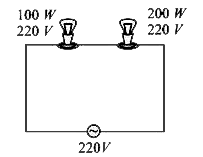n identical light bulbs, each designed to draw P power from a certain voltage supply , are joined in series across that supply. The total power which they will draw is
nP
P
P/n
P/n2
The correct Answer is:C
To solve the problem, we need to determine the total power drawn by n identical light bulbs, each designed to draw P power when connected to a voltage supply, when they are connected in series.
1. Understand the Power of a Single Bulb:
Each bulb is designed to draw a power P when connected to a voltage V. The relationship between power, voltage, and resistance is given by the formula:
\(
P = \frac{V^2}{R}
\)
where R is the resistance of one bulb.
2. Calculate the Resistance of One Bulb:
Rearranging the formula gives us the resistance:
\(
R = \frac{V^2}{P}
\)
3. Connect n Bulbs in Series:
When n identical bulbs (resistors) are connected in series, the total or equivalent resistance Req is the sum of the individual resistances:
\(
R_{eq} = n \cdot R
\)
Substituting the value of R from step 2:
\(
R_{eq} = n \cdot \frac{V^2}{P}
\)
4. Calculate the Total Power in Series:
The total power P' consumed by the series connection of the bulbs can be calculated using the power formula:
\(
P' = \frac{V^2}{R_{eq}}
\)
Substituting the expression for Req:
\(
P' = \frac{V^2}{n \cdot \frac{V^2}{P}} = \frac{P}{n}
\)
5. Conclusion:
The total power drawn by n identical light bulbs connected in series is:
\(
P' = \frac{P}{n}
\)
Final Answer:
The total power which they will draw is \( \frac{P}{n} \).
---
Each bulb is designed to draw a power P when connected to a voltage V. The relationship between power, voltage, and resistance is given by the formula:
\(
P = \frac{V^2}{R}
\)
where R is the resistance of one bulb.
Rearranging the formula gives us the resistance:
\(
R = \frac{V^2}{P}
\)
When n identical bulbs (resistors) are connected in series, the total or equivalent resistance Req is the sum of the individual resistances:
\(
R_{eq} = n \cdot R
\)
Substituting the value of R from step 2:
\(
R_{eq} = n \cdot \frac{V^2}{P}
\)
The total power P' consumed by the series connection of the bulbs can be calculated using the power formula:
\(
P' = \frac{V^2}{R_{eq}}
\)
Substituting the expression for Req:
\(
P' = \frac{V^2}{n \cdot \frac{V^2}{P}} = \frac{P}{n}
\)
The total power drawn by n identical light bulbs connected in series is:
\(
P' = \frac{P}{n}
\)
The total power which they will draw is \( \frac{P}{n} \).
Topper's Solved these Questions
- HEATING EFFECT OF CURRENTBOOK - CENGAGE PHYSICS ENGLISHCHAPTER - HEATING EFFECT OF CURRENTEXERCISE - Multiple Correct
5 Videos
- HEATING EFFECT OF CURRENTBOOK - CENGAGE PHYSICS ENGLISHCHAPTER - HEATING EFFECT OF CURRENTEXERCISE - Assertion - Reasoning
6 Videos
- HEATING EFFECT OF CURRENTBOOK - CENGAGE PHYSICS ENGLISHCHAPTER - HEATING EFFECT OF CURRENTEXERCISE - Subjective
8 Videos
- GEOMETRICAL OPTICSBOOK - CENGAGE PHYSICS ENGLISHCHAPTER - GEOMETRICAL OPTICSEXERCISE - Integer Type
4 Videos
- INDUCTANCEBOOK - CENGAGE PHYSICS ENGLISHCHAPTER - INDUCTANCEEXERCISE - Concept Based
8 Videos
Similar Questions
n identical bulbs, each designed to draw a power p from a certain voltage supply, are joined in series across that supply. The total power which they will draw is
View SolutionIf two bulbs, both of rated power 100 W at 220 V, are connected in series with a 220 V supply, the total power consumed by the bulbs will be:
View Solution
Knowledge Check
Two electric bulbs, each designed to operate with a power of 500W in 220V line, are in series with a 110V line. What will be the power generated by each bulb?
A31.25WB21.25WC11.25WD9.25W
Two bulbs 60 W and 100 W designed for voltage 220 V are connected in series across 220 V source. The net power dissipated is
View SolutionAn electric bulb is designed to draw P0 power at V0 voltage. If the voltage is V, it drawas power. Then
View SolutionWhen electric bulbs of same power, but different marked voltage are connected in series across the power line, their brightness will be :
View SolutionPower generated across a uniform wire connected across a supply is H. If the wire is cut into n equal parts and all the parts are connected in parallel across the same supply, the total power generated in the wire is
View SolutionWhen three identical bulbs of 60W,200V rating are connected in series to a 200V supply, the power drawn by them will be
View SolutionA 220 volt, 1000 watt bulb is connected across a 110 volt mains supply. The power consumed will be
View Solution200W and 100W bulbs, both meant for operation at 220V are connected in series to a 200V supply. The power consumed by them will be approximately :

View Solution
